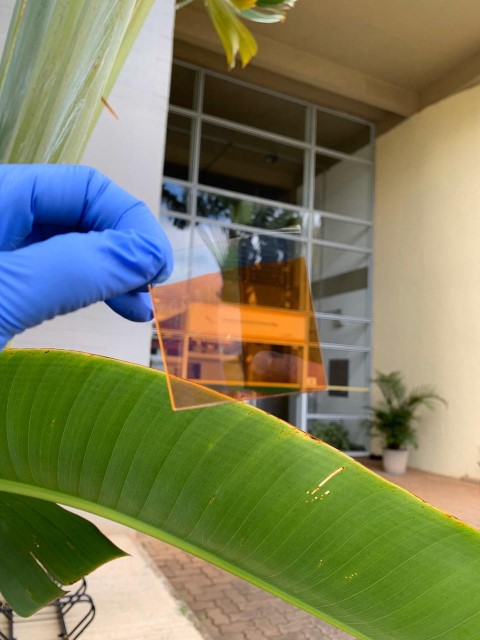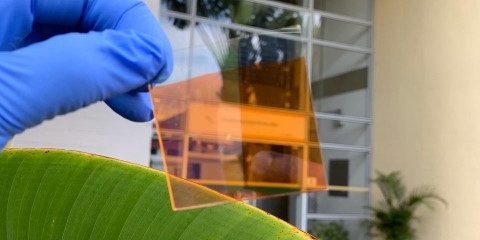Discovery, which combines low-cost and abundant materials, begins to be incorporated into prototype solar reactor for artificial photosynthesis

Researchers from the Brazilian Center for Research in Energy and Materials (CNPEM), organization under supervision of the Brazilian Ministry of Science, Technology and Innovations (MCTI) have just published a paper in the Journal of Materials Chemistry A, in which they present the results of combination processes of germanium and hematite nanoparticles to improve the efficiency of solar energy use in the breakdown of water molecules to obtain hydrogen.
The article, which had the collaboration of researchers from the Federal Universities of São Carlos and ABC, presents germanium as a possible ideal element in combination with hematite for use in photoelectrochemical cells.
Record
The best results, obtained through experiments with several methods for combining the materials, pointed to a capacity of photocurrent generation of 3.2 milliamperes per square centimeter.
This result is almost double that obtained in 2019, in the first studies with this purpose at CNPEM and sets a new Latin American record in that which is the main parameter for determining energy efficiency in manipulated materials aimed at generating hydrogen in a clean and sustainable way, without using raw materials obtained from oil. Few research groups in the world, including Korea, Switzerland, Israel, and the United Kingdom, dominate the knowledge of processes that allow results on this scale.
“This field of research is inspired by nature. The goal is to imitate the photosynthesis carried out by plants, which uses sunlight to separate hydrogen and oxygen molecules from water and create processes that can be called artificial photosynthesis. There is a global effort to develop solutions that make the processes increasingly efficient and economically feasible,” explains CNPEM researcher Edson Leite.
Artificial Photosynthesis
Mastering the technology of artificial photosynthesis to obtain hydrogen has enormous potential to contribute to solutions for serious problems generated by the energy matrix that threaten the future of life on the planet.
One of the ways to produce hydrogen is from the breakdown of water molecules (H2O) forming H2 molecules. This breakdown is done in a process called photoelectrolysis, which happens in a very similar way to the production of electricity from sunlight in photovoltaic plates.
To put it simply, the sunlight that reaches the solar panels is absorbed by the electrons of the material that constitute these devices. The electrons are then expelled from the atoms with which they were associated, and form the electric current that can be used, for example, to charge a battery or to run electrical equipment.
Similarly, in photoelectrochemical devices, electrons are released from the material by incident sunlight. In an aqueous medium, the “hole” left behind attracts electrons belonging to the water molecule, causing the chemical bonds between the oxygen and hydrogen atoms to be broken. Now free, the hydrogen atoms recombine into hydrogen gas, which can then be collected, stored, and used later for energy production.
“This gas is still particularly interesting as an energy source because its combustion generates as a product only water vapor, unlike fossil fuels. It is a form of simultaneous production and storage of energy”, summarizes Leite.
However, for this technology to become economically feasible, several engineering and research challenges still need to be overcome.
Challenges
In addition to the numerous challenges related to increasing the efficiency of energy generation and reducing the environmental impact of the production of solar panels, there is yet another problem to be solved: how to maintain the production of electricity during periods of absence of sunshine?
The daily and seasonal intermittency, not only of solar energy production, but also wind and other renewable sources, requires that different production modalities be combined to guarantee the supply and adequate distribution of electric energy.
Another challenge is the storage of energy produced during sunny days for use at night or on days with less sun exposure. This storage can be done either in a new generation of high-capacity batteries or by efficiently converting this solar energy into chemical fuels that can be stored and then used for energy production according to demand, just as plants do through the process of photosynthesis.
These two developments are in the focus of the energy research program of the Brazilain Nanotechnology National Laboratory of CNPEM/MCTI, which involves the use of nanotechnology tools to solve fundamental problems that lead to low efficiency of these electrochemical processes and thus make them more economically competitive.
Prototype of the reactor under patent
For researcher Edson Leite, the efficiency measured recently in the processes that use the combination of hematite and germanium has already allowed the development of a prototype solar reactor, which is in the patent application phase, with the aim of obtaining hydrogen in a clean and sustainable way.
“We will work on the material to find ways to further increase the energy efficiency, but the knowledge that has been accumulated in recent years already encourages us to start experiments on a larger scale, aiming to develop devices that explore the full potential that this combination of these abundant and low-cost materials can offer.
Sirius, a differential
Sirius, a state-of-the-art synchrotron light source, which is in operation at the CNPEM campus, can be used in the next steps of this type of research. The infrastructure was designed to offer resources at the frontier of science for the study of various types of materials.
“One of the fastest ways to advance in the development of these materials is to combine experiments capable of visualizing in real time, during the operation of this device, the breakdown of the water molecule and the production of hydrogen, as is possible in synchrotron light sources like Sirius. The Carnaúba experimental station, for example, will be essential for our fundamental understanding of materials and processes,” explains CNPEM researcher Flávio Leandro de Souza.
About Sirius
Designed and built by Brazilians and funded by the Ministry of Science, Technology and Innovation (MCTI), Sirius is one of the most advanced synchrotron light sources in the world. This great scientific equipment has at its core a state-of-the-art electron accelerator, which generates a type of light capable of revealing the microstructure of organic and inorganic materials. These analyzes are carried out at research stations, called beamlines. Sirius will support several beamlines, optimized for different experiments, and that will work independently of each other, allowing several groups of researchers to work simultaneously, in different research in the most diverse areas, such as health, energy, new materials, environment, among others.
The experimental techniques available in Sirius’ beamlines will make it possible to observe microscopic aspects of materials, such as the atoms and molecules that constitute them, their chemical states and their spatial organization, in addition to following the evolution over time of physical, chemical and biological processes that occur in fractions of a second. In a beamline it is also possible to follow how these microscopic characteristics are changed when the material is subjected to different conditions, such as high temperatures, mechanical stress, pressure, electric or magnetic fields, corrosive environments, among others. This capability is one of the main advantages of synchrotron light sources when compared to other high resolution experimental techniques.
Sirius’ beamlines are advanced scientific instruments, designed to solve problems in strategic areas for development. Initially, a set of 14 beamlines was planned to cover a wide variety of scientific programs. In total, Sirius will be able to house up to 38 beamlines.
About CNPEM
Sophisticated and effervescent environment for research and development, unique in Brazil and present in few scientific centers in the world, the Brazilian Center for Research in Energy and Materials (CNPEM) is a private non-profit organization, under the supervision of the Ministry of Science, Technology and Innovations (MCTI). The Center operates four National Laboratories and is the birthplace of the most complex project in Brazilian science – Sirius – one of the most advanced synchrotron light sources in the world. CNPEM brings together highly specialized multi-thematic teams, globally competitive laboratory infrastructures open to the scientific community, strategic lines of investigation, innovative projects in partnership with the productive sector and training of researchers and students. The Center is an environment driven by the search for solutions with impact in the areas of Health, Energy and Renewable Materials, Agro-environment, and Quantum Technologies. As of 2022, with the support of the Ministry of Education (MEC), CNPEM expanded its activities with the opening of the Ilum School of Science. The interdisciplinary higher course in Science, Technology and Innovation adopts innovative proposals with the aim of offering excellent, free, full-time training with immersion in the CNPEM research environment.


